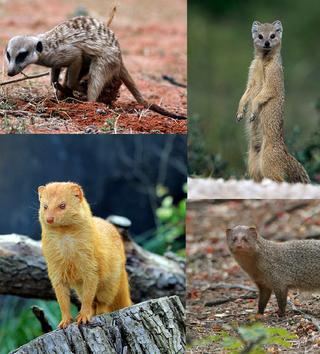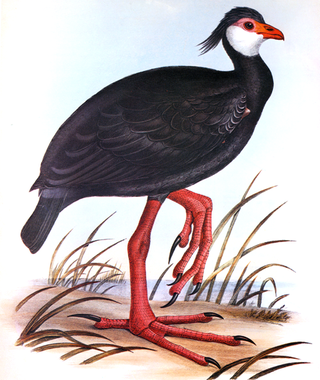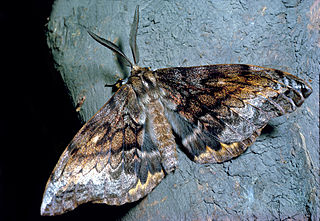| Chelepteryx | |
|---|---|
 | |
| Male and female Chelepteryx collesi | |
| Scientific classification | |
| Kingdom: | |
| Phylum: | |
| Class: | |
| Order: | |
| Family: | |
| Genus: | Chelepteryx |
| Synonyms | |
| |
Chelepteryx is a genus of moths of the family Anthelidae first described by George Robert Gray in 1835.
| Chelepteryx | |
|---|---|
 | |
| Male and female Chelepteryx collesi | |
| Scientific classification | |
| Kingdom: | |
| Phylum: | |
| Class: | |
| Order: | |
| Family: | |
| Genus: | Chelepteryx |
| Synonyms | |
| |
Chelepteryx is a genus of moths of the family Anthelidae first described by George Robert Gray in 1835.

A mongoose is a small terrestrial carnivorous mammal belonging to the family Herpestidae. This family is currently split into two subfamilies, the Herpestinae and the Mungotinae. The Herpestinae comprises 23 living species that are native to southern Europe, Africa and Asia, whereas the Mungotinae comprises 11 species native to Africa. The Herpestidae originated about 21.8 ± 3.6 million years ago in the Early Miocene and genetically diverged into two main genetic lineages between 19.1 and 18.5 ± 3.5 million years ago.

Kingsnakes are colubrid New World members of the genus Lampropeltis, which includes 26 species. Among these, about 45 subspecies are recognized. They are nonvenomous and ophiophagous in diet.

John Edward Gray was a British zoologist. He was the elder brother of zoologist George Robert Gray and son of the pharmacologist and botanist Samuel Frederick Gray (1766–1828). The standard author abbreviation J.E.Gray is used to indicate this person as the author when citing a botanical name. The same is used for a zoological name.

George Robert Gray was an English zoologist and author, and head of the ornithological section of the British Museum, now the Natural History Museum, in London for forty-one years. He was the younger brother of the zoologist John Edward Gray and the son of the botanist Samuel Frederick Gray.

Buccinoidea is a taxonomic superfamily of very small to large predatory sea snails, marine gastropod mollusks.

Fissurellidae, common name the keyhole limpets and slit limpets, is a taxonomic family of small to medium-sized limpet-like sea snails, marine gastropod molluscs in the clade Vetigastropoda.

Oliva is a genus of medium-sized to large sea snails, marine gastropod mollusks in the subfamily Olivinae of the family Olividae, the olive snails or olive shells. Many former species of Oliva have been reclassified under genus Americoliva.

Dosinia is a genus of saltwater clams, marine bivalve molluscs in the family Veneridae, subfamily Dosiniinae Deshayes, 1853. The shell of Dosinia species is disc-like in shape, usually white, and therefore is reminiscent of the shells of Lucinid bivalves.

Trimusculus is a genus of medium-sized air-breathing sea snails or false limpets, marine pulmonate gastropod molluscs in the family Trimusculidae.

The black-browed barbet is an Asian barbet native to Peninsular Malaysia and Sumatra, where it inhabits foremost forests between 600 and 2,000 m altitude. It is listed as Least Concern on the IUCN Red List because of its wide distribution and stable population.

Herpestes is a genus within the mongoose family Herpestidae. Several species in the family are known as slender mongooses. It is the type genus of the family, and comprises 5-6 living species, each with several subspecies. Fossil remains of three prehistoric species were excavated in France, and described in 1853.

Atrina is a cosmopolitan genus of bivalve molluscs belonging to the family Pinnidae.

Chelepteryx collesi, the batwing moth or white stemmed gum moth, is a moth of the family Anthelidae. The species was first described by John Edward Gray in 1835. It is found in Australasia.

Diodora is a genus of small to medium-sized keyhole limpet in the family Fissurellidae.

Fissurella is a genus of small to medium-sized sea snails or limpets, marine gastropod mollusks in the subfamily Fissurellinae of the family Fissurellidae, the keyhole limpets.
Hespererato is a genus of small sea snails, marine gastropod mollusks in the family Eratoidae, the false cowries or trivias.

Pitar is a genus of saltwater clams, marine bivalve molluscs in the subfamily Callocardiinae of the family Veneridae, the Venus clams. The genus contains over 60 species.
The 56th Massachusetts General Court, consisting of the Massachusetts Senate and the Massachusetts House of Representatives, met in 1835 during the governorship of John Davis. Benjamin T. Pickman and George Bliss served as presidents of the Senate. Julius Rockwell served as speaker of the House.

The Diodorinae, common name keyhole limpets and slit limpets, is a taxonomic subfamily of limpet-like sea snails, marine gastropod molluscs in the family Fissurellidae, the keyhole limpets and slit limpets.